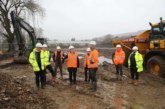Richard Tibenham of climate tech firm IES says upgrading the UK’s existing buildings will be key to coping with future record heat.
The confirmation that 2023 was the hottest year ever recorded demonstrates the huge impact climate change is already having on temperatures around the globe. Last year was about 1.48˚C warmer than pre-industrial levels, with almost every day since July bringing a new high-temperature record.
These soaring temperatures take a major toll on human health and contribute to excess deaths. It is therefore of paramount importance that we tackle the issue of overheating within our homes and infrastructure, as well as the root cause of the rising temperatures.
Part O regulations introduced last year are a positive first step, mandating that new-builds should be constructed to higher standards and account for overheating from the outset of the design. But these regulations do not apply to commercial buildings, existing buildings and retrofits, meaning swathes of the UK’s current building stock are not equipped to deal with such hot temperatures year after year.
This means places like offices, schools and other public buildings will continue to be affected significantly by high levels of heat unless immediate action is taken. It is in a business or local authority’s best interest to invest and upgrade these buildings to reduce the impact heat has on productivity and concentration, yet building owners and operators remain confused about what measures need to be implemented.
While many may think first of mechanical methods to cool properties down, such as air conditioning, these measures only increase energy consumption and burden the planet further, as well as increasing the demand on the grid. Instead, these measures should be considered as a last resort and passive solutions should be the first port of call. Such measures include natural ventilation, solar shading, improved thermal mass and insulation. Airtightness also aids in stabilising internal temperatures.
Cutting-edge digital twin technology can accurately model existing buildings and simulate the effects of different energy efficiency measures, so building owners can make informed decisions on how to keep their buildings cool that are both effective and cash conscious. Property developers can also use this technology to determine how properties can be constructed with the aim to stay cool in summer and warm in winter.
As the climate crisis escalates, overheating risks for UK buildings will only grow. Record high temperatures will become more common, so urgent action and investment are required to upgrade our building stock if we are to optimise occupant comfort and wellbeing and equip our built environment with the means to withstand the impact.










